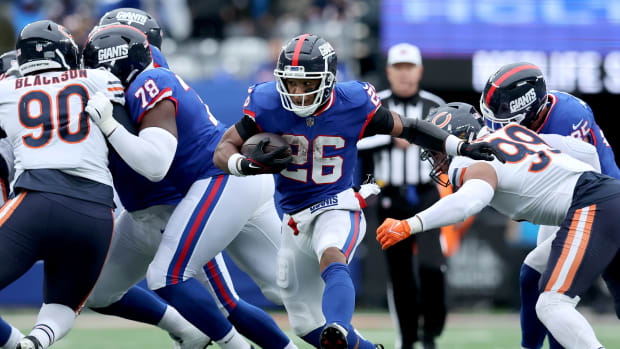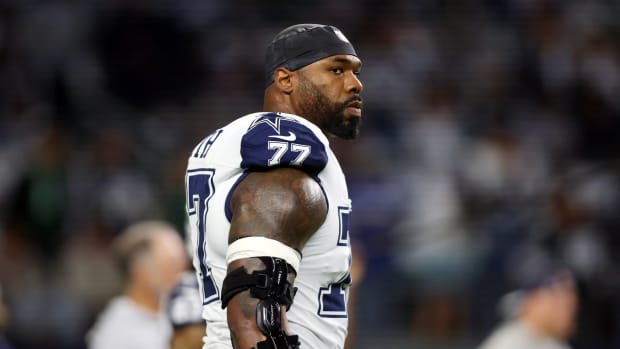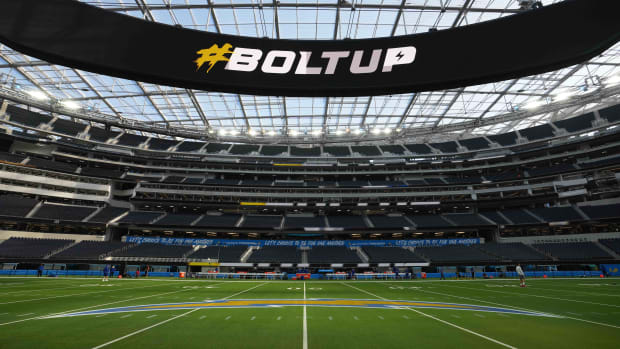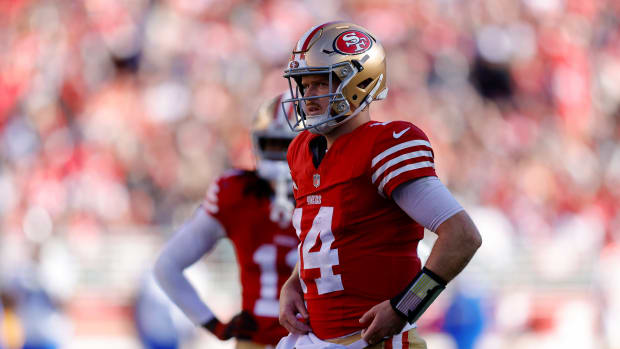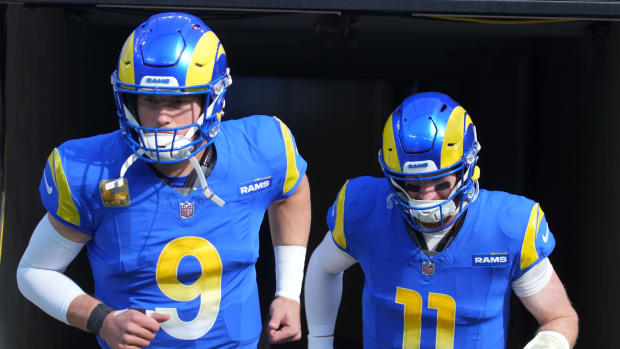NFL Cheerleading Can Still Be Saved
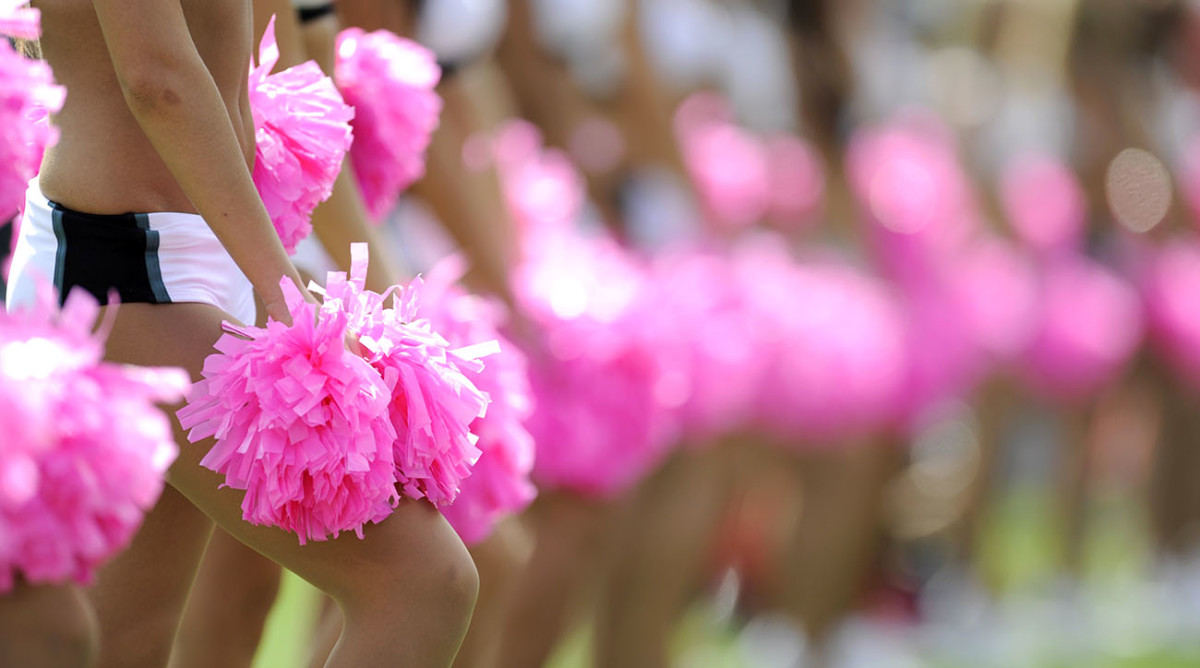
Bailey Davis couldn’t wait for the calendar reveal party. This was August 2016, in her second year as a member of the Saintsations, the New Orleans Saints cheerleaders, and she’d worked so much harder on toning her body for the calendar shoot than she had as a rookie. She’d been eating clean, going to Pure Barre and CrossFit and she’d even won a plank competition by holding the pose for 33 minutes. The result was her very first six-pack, a tangible sign of her discipline. She hoped that six-pack would help her make the cut—her own month on the calendar.
Davis arrived at New Orleans’ Royal Sonesta Hotel with her teammates, all dressed in black cocktail dresses for the formal event. They greeted team sponsors and Saints employees, but mostly they whispered about who might get a month this year. The first sign of trouble was the team photo—four rows of smiling women in white bikinis—projected across the backdrop of the ballroom stage. Davis’s eyes were stuck on the middle of the second row, on the altered version of herself. Her breasts had been noticeably enlarged, and the change wasn’t subtle; teammates (some of whom have actually had breast augmentation) teased her about her double-Ds. “I was super embarrassed,” Davis says. “It was the first thing you saw when you walked in.”
Throughout the course of the night, each page of the 16-month calendar was revealed for the first time, January 2017 through April 2018. Davis, who had a page as a rookie, sat through 11 months, growing anxious as she waited to see if she had made the cut. Relief came with the reveal of December; her photo flashed on screen, in a red bikini, posing on a waterbike. Her chest was back to its normal size—an obvious difference from the group shot plastered on the backdrop of the stage. But the moles on her stomach were missing, and her six-pack had been erased.
Davis was annoyed at her smoothed-over stomach, but she wasn’t completely surprised. Airbrushing away all traces of perceived masculinity had been a trademark of the Saintsations swimsuit calendar long before Davis joined the team.
“No one had a six-pack in the calendar,” she says. “I wanted a rip-tuck picture for the calendar, but they smoothed it over because someone said, Guys don’t like six packs on girls.”
(In a statement to The MMQB, outside counsel for the Saints said that until June 2017 the Saintsations were outsourced to a third party-organization, St. All-Star LLC, including the 2015 and ’16 seasons, Davis’s first two years with the team. The Saints discontinued the calendar after the 2017-18 edition in question, which was prepared in 2016.)
Growing up, Davis had an especially close connection to the Saintsations—her mom worked for them as a field director, one of several assistants for the squad—and always dreamed of dancing on the sideline in black and gold. She joined the dance team at Jones County Junior College and tried out as soon as she was old enough for the Saintsations. She expected it to be the height of her dance career and push her to improve her technique. But once she made the team, the reality was much different. “Routines got watered down to look better for the girls who couldn’t really dance,” she says. “If you gained a little bit of weight or if you didn’t sell enough calendars, you weren’t going on the field. Everything but your ability determined whether you got to dance or not.”
At most high school and college programs, cheerleaders and dancers are considered part of the athletic program and treated like any other student-athlete. But the image and role of a cheerleader changes drastically in the professional ranks. The women who were considered athletes in college are presented as little more than over-sexualized male fantasies in the pros. “I don’t know why we get to the professional leagues and it’s like, Oh, you’re just eye candy.,” Davis says.
Davis was fired from her Saints job in January over rumors that she was at the same party as a Saints player (the rulebook forbids any fraternization with players) and a photo posted on her private Instagram account. In the photo she is wearing a one-piece lace bodysuit, deemed to violate the team’s rule of no nude, semi-nude or lingerie shots. (Her mother has since voluntarily resigned.) “They said I had a ‘dirty face’ in the picture,” Davis says. “It was a serious face, the same face I make in the photo on all the posters we give to kids.”
NFL cheerleading teams are on the hot seat. The New York Times published a disturbing report of a swimsuit calendar shoot for Redskins cheerleaders, which some team members said turned into a topless shoot in front of sponsors and suite holders. Davis and Kristan Ann Ware, a former Miami Dolphins cheerleader, recently filed gender-discrimination complaints with the Equal Employment Opportunity Commission against the Saints, the Dolphins and the NFL. With their legal action, the NFL cheerleading industry, which to this point has operated outside the realm of the #MeToo movement, is now forced to recognize and confront its unfair treatment of the women it employs. Sara Blackwell, who represents Davis and Ware, sent the NFL a settlement proposal: If commissioner Roger Goodell and the NFL’s lawyers agree to a four-hour meeting with her clients to prepare a set of regulations for all NFL cheer teams, they will settle all claims for $1 each. Earlier this week, the NFL (though not Goodell himself) agreed to meet with the group, and Blackwell plans to suspend the complaints for now.
Many have argued that the NFL just shouldn’t employ cheerleaders anymore. That’s the wrong idea—eliminating a role for women in the predominantly male world of professional football is the opposite of empowering them. “When a cheerleader complains, the organization will say, fine, let’s just get rid of the cheerleaders,” Ware says. “That’s not the point. That’s abusive and manipulative.”
And when you take away the sexualization of NFL cheerleaders, the job is empowering. The women who make the team are not just pretty faces. They must pass an arduous audition process that often includes a test about the organization’s history and the game of football, and an interview segment where hopefuls dress in business attire and answer questions from local professionals to prove they can handle the responsibility of representing the organization in the community and abroad. They log hours of community outreach, and many have been involved on USO tours.
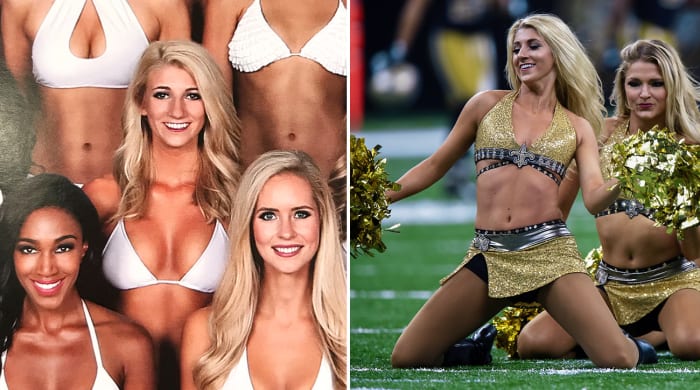
Davis in the altered swimsuit calendar photo (left), and performing at a game during the 2016 season (right).
Courtesy Bailey Davis (calendar); Icon Sportswire/Getty Images (action)
These are women who should be held up as role models for young girls. It’s time to rebrand them as athletes, not sex symbols, so they can be treated with the respect that they deserve. I was a college cheerleader at Northwestern, and I never once felt objectified. NFL cheerleading needs to return to its traditional collegiate roots. No more online voting for your favorite cheerleader. No more “Cheerleader of the Week” photo galleries (of which Sports Illustrated has been guilty). No more swimsuit calendars. No more creepy team slogans like Football’s Fabulous Females, or marketing the cheer team as “the most beautiful ladies of the South.” The NFL needs to focus on the athleticism and detailed precision that it takes to be an NFL cheerleader.
It’s easy to brush off complaints about making little more than minimum wage, or adhering to a controlling rulebook, or facing harassment from fans and their own coaches—after all, no one is being forced to be an NFL cheerleader. But for Ware and Davis, being a professional cheerleader was the fulfillment of a lifelong dream, and there’s nothing like the thrill of performing in front of tens of thousands of fans. I know what that rush is like—there was no better feeling than running the team onto the field carrying the W-I-L-D-C-A-T-S flags. A firework blast was our queue to run—we’d take off sprinting through a wall of smoke as the team followed behind us. I don’t think I’ve ever run faster in my life, fueled by the zero-to-60 adrenaline boost (and by the fear of getting trampled by the giant players behind us).
The reasons Davis, Ware and I love cheerleading are the same reasons you love the sport you played. The camaraderie of being on a team, the honor and responsibility of representing an organization, the opportunities to travel and meet new people, and the thrill of performing your craft every week.
“Sometimes the good moments make it worth putting up with the bad to do what you love,” Davis says. The unfortunate reality of NFL cheerleading is that there are a lot more bad moments than there are good.
I asked Ware and Davis for their wish list of changes to fix NFL cheerleading, a list similar to what they’d discuss with the league—if the league chooses to listen.
1. PRIORITIZE DANCE ABILITY, NOT BODY TYPE. NO MORE WEIGH-INS.
“We should be able to have muscular bodies,” Davis says. “If we don’t have boobs, we don’t have boobs. We shouldn’t be so worried about being a man’s idea of an NFL cheerleader or perfect body.”
In her third and final year with the Dolphins, Ware says the image of the team’s cheerleaders shifted dramatically. She says she heard a Dolphins executive say that he wanted women on the team to look like Victoria’s Secret models, not dancers. “We saw really talented dancers get cut at auditions, and we’re wondering, wait, what just happened?” Ware says. “And then we saw a really pretty model make the team who had no dance background. You start to scratch your head. Are we dancers, or are we models?”
(In a statement to The MMQB, a team spokesperson for the Dolphins said: “Ms. Ware brought some things to our attention when she was a cheerleader and they were addressed at that time. Some of her recent statements are new information to us and in some cases we believe they are misunderstandings. For example, SI Swimsuit and Victoria’s Secret was referenced in terms of the artistic vision of our cheer brand. We wanted to take it to another level of photography and quality, but this wasn’t a factor in our cheerleader selection process.”)
Says Davis: “Some of the best dancers I know don’t want to be NFL cheerleaders because it is degrading and it’s not an actual dance job. The emphasis needs to be on what it is in college and high school, where dance team is a sport.”
Part of changing that emphasis is changing the outfits. Bedazzled push-bras and spandex booty shorts doesn’t portray the image of a serious athlete. At the risk of sounding like a cranky old lady: These women need to wear more clothes. The uniforms should take the form of the classic college cheerleading look, skirts and crop tops that highlight their six-packs without revealing major cleavage.

On the left, the Philadelphia Eagles cheerleaders at an opening-week game in 2016. On the right, the more reasonably clothed Northwestern University cheerleaders at an opening-week game in 2014 (the author of this article is fourth from the left).
Getty Images (2)
If NFL cheerleaders are no longer objectified, teams will have no reason to hold women to unhealthy body standards. Both Davis and Ware say they were subjected to weekly weigh-ins to make sure they were at or below the weight they had auditioned at. (Through counsel, the Saints said they have never required cheerleaders to submit to weekly weigh-ins.)
Ware says many teams, like the Dolphins, had a three-pound leniency rule. Anything heavier is grounds for suspension, and in some cases, termination. Ware says laxative abuse was common, and Davis says teammates would often sweat themselves out in their cars and starve themselves to make weight. The severe consequences of failing a weigh-in create an environment where eating disorders are normal.
At the end of Ware’s rookie season, a teammate was called into the coach’s office during practice. Ware watched in horror as her teammate exited the office crying, packed her bags and left the building. A team captain told Ware the woman was fired because the coaches thought she was overweight, and that she was on the last week of a medication that had caused her to gain a few pounds. (In reviewing questions for this story, the Dolphins did not specifically respond to a question about this incident, or about weigh-ins.)
2. ELIMINATE THE CULTURE OF FEAR
Each team operates under its own set of rules, so experiences vary, but Davis and Ware both experienced a culture of intimidation. Both were frequently reminded by coaches that if they stepped out of line or complained, there were hundreds of other women waiting to take their spots. “You’re reminded of that every single week,” Ware says. “You’re seen and not heard.”
This culture of fear is the reason why NFL cheer teams have been able to largely avoid the #MeToo reckoning until now. Ex-cheerleaders feel comfortable speaking out because they are free from the threat of losing their spot. Current cheerleaders are trapped in the system. When Davis was fired, she says her teammates were sad to lose her, but reminded her that she knew the rules, so she shouldn’t have posted the picture to Instagram in the first place. And when she announced her lawsuit, the reaction was worse. Her closest friend on the team no longer speaks to her.
“If you went inside the locker room and you said, girls, is there anything going on? They would all smile at you and say everything is fine,” Ware says. “I’ve been there. I’ve watched the cheerleaders lie about that because they are too afraid that they are going to lose their job.”
3. MAKE IT A FULL-TIME JOB
These women are part-time employees of the teams they cheer for. Most of them hold full-time jobs and serious careers outside of cheerleading. Last year’s Patriots cheerleading squad included an attorney in the D.A.’s special investigations office and a second lieutenant in the Air Force. Ware worked three other jobs in Miami, and Davis was a full-time student.
During her three years on the Saintsations, Davis was required to show up to every practice with full hair and makeup done, because the team practiced in a public gym. She was only paid $9.25 an hour for game day, practice time, and for up to four hours of time for each community appearance. The Saintsations practice twice a week for roughly four hours each, but are also expected to practice on their own. The women call this “practice for practice” because they are not guaranteed a spot on the field. They have to earn their position every week. Davis drove two hours each way to practice while she was attending college in Hattiesburg, Mississippi. She wouldn’t get home until past midnight, and had to get up the next morning early to go to class. Last Halloween, she pulled all-nighters for three days in a row because she was in charge of making her field group’s Halloween costumes. At night, she hot glued Peter Pan and dwarf costumes together, and during the day she struggled to stay awake in class. “I came to class one day and my eyes were bloodshot, and people were like, are you on drugs?” Davis says. “I was so obsessed with Saintsations that I put it before school.”
Both Ware and Davis were expected to pay for most of their own beauty treatments—most teams require manicured nails and spray tans, among other appearance rules, for games and community appearances. The Saints provided a stylist on game days, but Davis paid for semi-monthly manicures, a makeup set for community appearances, an annual spray tan membership, false eyelashes for every game and appearance and 20 pairs of tights each year. Add that all up, and she paid roughly $2,240 each year to maintain her look. While listing all the associated expenses, Davis confesses, “You’re probably looking at it and I made no money.”
In Miami, Ware says that coaches told them they were the highest paid cheerleaders in the NFL. She’s not comfortable disclosing her hourly wage, but she says it still wasn’t enough to live on. She worked three other jobs, as a fitness instructor, resort activities manager and at a massage therapy studio. “I felt like I was paying to be a cheerleader,” she says. “We would all say on the Dolphins that it is a full-time job and part-time pay.”
Dolphins cheerleaders practiced three times per week in Miami, plus an added practice on Saturdays during weeks when they had a performance during a home game. On top of that, she was frequently requested for appearances in the community, which she loved doing. Between appearances and practice, NFL cheerleading could easily become a full-time job if teams added a morning practice, or a shift working in the team office before evening practice.
If this was a full-time job, or even just a better-paying part-time job, the women wouldn’t have to balance multiple jobs and drive themselves to exhaustion working a full day and then rushing to a full night of practice. Cheerleaders should also receive a stipend or be reimbursed for the expensive beauty regimen and accessories required.
4. PROPER MEDICAL TREATMENT FOR ALL CHEERLEADERS
Ware struggled with several injuries and says she was pressured to perform through her pain and didn’t receive proper medical treatment. She says she danced on four broken bones, two sprained MCLs, two sprained meniscuses, a left shoulder injury and a right hip injury. She says that when she’d ask about resting her injuries, Miami’s cheerleading directors repeated a familiar threat: If you don’t perform, there are 100 other women who will take your position. (The Dolphins did not specifically respond to these assertions.) Ware left the team nearly a year ago and she says her foot is still broken. She currently does not have health insurance and is trying to do her own physical therapy exercises at home.
Cheerleaders shouldn’t have their injuries used against them, and considering the physical demands of the job they need much more than that. They should have a dedicated athletic training staff for their care.
5. USE LAST NAMES
Every NFL cheerleading team refers to their cheerleaders by first name only. Bailey Davis was just Bailey, Kristan Ann Ware was just Kristan Ann. Taking away their last names takes away a piece of their credibility—they’re ambassadors for a professional football organization. I can’t think of another serious female athlete or performer who isn’t known by her last name. Some teams tell women that this is for their protection from would-be stalkers, but when I perused the cheerleading websites for the 26 NFL teams that have squads, I found a lot of information in the cheerleader bios (college, hometown, industry she works in).
When Davis taught at dance camps and workshops and chose to use her full name, she wasn’t allowed to say that she was a Saintsation. Davis wants to build a career in the dance world, and not being able to reference a job as a professional dancer when trying to book other jobs didn’t help.
“They say, this is going to be the best years of your life, you’re going to do so much networking and you are going to get a great job after this,” Ware says. “But when you meet someone and you can’t use your last name, how are they going to find you?”
The suits filed by Davis and Ware aren’t demanding million-dollar contracts or the kind of treatment given to players. They are simply asking to be treated like valued members of the organization: more pay, more security, better treatment, more recognition of their talent.
At Northwestern, the cheerleaders weren’t half as important as the football team (nor did we think we should be). There were certain rules that we knew to follow. We always boarded the charter plane at the back entrance, while the football players boarded at the front. We’d ride in the last bus, and we’d wait to grab our post-game meal until after the players got theirs. We were viewed as “half-letes” by many of the other student-athletes because we weren’t a competitive team.
But we still got to travel comfortably to the games, we still received varsity letters, and we still had a coach who cared for us. We were treated with respect and felt like we mattered. Our athletic director and football and basketball coaches would often thank us after games for creating a great home-game environment.
In 2014, several former members of the Buffalo Bills cheerleading team, the Buffalo Jills, sued the Bills for not being paid for the majority of the hours they worked. Faced with the lawsuit, the Bills suspended operations for their cheerleading team; the Jills have not been revived. Instead of fixing the problems, the team chose to just avoid them altogether.
“If the NFL does away with us, then we are just taking a step backwards,” Davis says. “It shows the rest of the world that the NFL does not care about women, that we have no voice. I surely hope that a dad would not bring his daughter to an NFL game if they did away with cheerleaders because they didn’t want to deal with women.”
NFL teams devote plenty of resources to dealing with the athletes who perform on the field. It’s past time for them to rethink how they treat the athletes who work on the sidelines.
• Question or comment? Email us at talkback@themmqb.com.

































